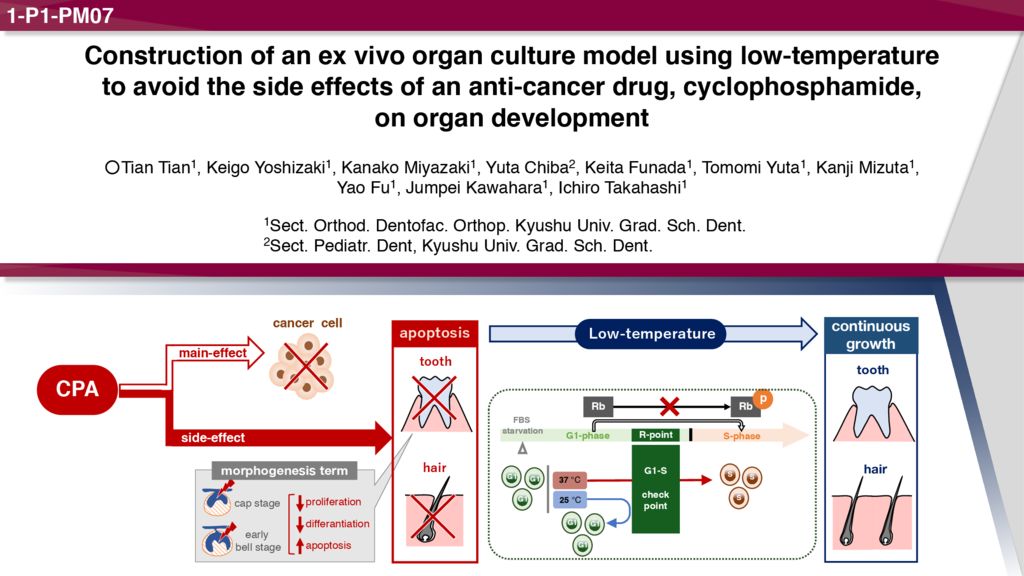Author: 〇田 甜1、吉崎 恵悟1、宮崎 佳奈子1、鮒田 啓太1、湯田 智美1、水田 敢士1、傅 堯1、川原 純平1、福本 敏2、高橋 一郎1
Affiliation: 1九大 院歯 矯正、2九大 院歯 小児口腔
Abstract:
Purpose Anti–cancer drug treatment causes severe side effects including tooth agenesis, dry mouth, hair loss, and taste loss. Most of these effects are reversible, whereas tooth defect is irreversible. Therefore, pediatric cancer patients who received chemotherapy, have to be suffered from the symptoms of teeth such as loss and defect of tooth, which results in severe oral dysfunction to the patients' life. Cyclophosphamide (CPA) is an alkylating agent that inhibit DNA replication, which is commonly used for cancer treatment in children such as leukemia. It is reported that treatment with CPA inhibits the tooth development in pediatric cancer patients, however the mechanism to avoid the side effects is unclear yet. In this study. we investigated the effect of CPA during tooth development. Moreover, we have constructed a system to avoid the side effects of anti-cancer drugs. Materials & Methods Organ culture was performed by using embryonic day 14, 16 and 18 (E14, E16 and E18) tooth germs treated with CPA. M3H1 dental epithelial cell line was analyzed by cell–counting, immunofluorescence, qRT–PCR and MTT assay. Comprehensive analysis in gene expression was performed using Cap Analysis of Gene Expression (CAGE). The cell cycle molecules were analyzed by Western blotting using M3H1 cells. Results & Conclusion Treatment of CPA disturbed the growth of tooth germs at E14 and E16 by inducing apoptosis and suppression of cellular proliferation and differentiation. However, CPA treatment on E18 tooth germs showed higher survival rate than the other CPA treated groups and formed tooth germ structure. Furthermore, we found that the organs cultured in low–temperature could avoid the CPA–mediated inhibition of organ morphogenesis and differentiation. To assess the molecular mechanism of the effect of culturing temperature on CPA treatment, genome–wide analysis of gene expression was conducted by using cap analysis of gene expression (CAGE). Differential gene expression analysis revealed that the expression of genes related to G1–S cell cycle checkpoint were down–regulated in the CPA–treated tooth germ cultured in low-temperature compared with that of cultured in conventional-temperature. In vitro analysis using dental epithelial cell line M3H1 revealed that low–temperature impeded Rb phosphorylation and caused cell cycle arrest at G1 phase, which can prevent the damage on DNA replication caused by cross linking reaction of CPA. Our results revealed that the side effects of CPA on organ development can be avoided by keeping low–temperature circumstance

 メールで問い合わせ
メールで問い合わせ

コメント